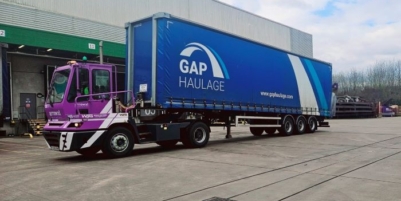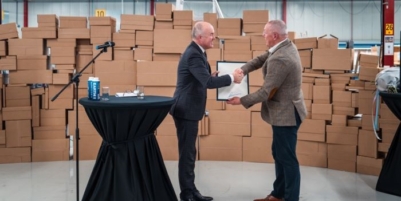-
Nutrivend selects Forterro’s Orderwise to support online expansion and streamline operations - April 11, 2025
-
ARROWXL LAUNCHES AMBITIOUS ZERO WASTE ROADMAP - April 8, 2025
-
THE BCMPA’S NEW CAMPAIGN DRIVES OUTSOURCING SUCCESS IN Q1 - April 7, 2025
-
BLACKOUT TECHNOLOGIES TARGETS TELEMATICS-INTEGRATED MOBILE DEVICE BLOCKING TO COMBAT SMARTPHONE DISTRACTION - April 1, 2025
-
Sparck Technologies awarded Royal designation - March 27, 2025
-
OpenADR Alliance announces first OpenADR 3.0 certified products with EVoke Systems, E.ON Energy and Universal Devices - March 25, 2025
-
Growing fulfilment and contract packer appoints new Managing Director - March 25, 2025
-
When is it time to invest in a WMS? Understanding the key trigger points - March 25, 2025
-
eCapital helps Vantage Recruitment on its journey to financial success - March 24, 2025
-
Hugo Beck Celebrates 70 Years of Packaging Innovation with Open House Events - March 20, 2025
Whether you agree that there is a climate change crisis or otherwise, it’s indisputable that sustainability has become an important aspect for businesses. Consumers want to buy from companies that operate in an eco-friendly way.
That’s a real challenge in an industry in which the use of transport and machinery to help prepare goods and get them from one destination to another, which could be a large distance, is so heavy. Wouter Satijn, Sales Director, Joloda Hydraroll, outlines the importance of sustainable transportation, what it means for businesses, and how to take steps towards operating a sustainable transportation company.
The importance of sustainable transportation
According to the World Bank, transport is the fastest-growing source of energy-related carbon emissions. Depending on where you live, transport contributes between 12 and 70% of urban air pollution. Indeed, the World Health Organisation’s (WHO) data suggests around 2.4 billion people are exposed to dangerous levels of household air pollution, and that such pollution kills 13 people per minute.
So, how can industry make transport more sustainable?
First, let’s consider what sustainable transportation actually is. Sustainable, or ‘green transportation’, is a broad term that describes the way an organisation might work to make its transportation practices and vehicles more environmentally friendly. Sustainable transport can also mean a variety of things, depending on the location in which it’s being implemented. It could create scope for a better quality of life for the citizens. It could mean working towards a more functional but green city. It could even mean bridging an inequality gap. Within a business context, examples of sustainable transportation measures may include using an electric vehicle fleet or reducing the number of miles between stops on routes that have more than one stop.
Within any setting though, there are three guiding elements – or Sustainable Development Goals (SDG) – that sit at the core of sustainable transport:
- Social: the development of safe, secure, and accessible mobility choices
- Environmental: creating solutions that decrease emissions and pollution, and protect the environment
- Economic: making the cost of transportation more affordable
Successful achievement of these elements of sustainable development also requires clear governance and management from the highest level within any organisation.
The cost-saving benefits of sustainable transportation for businesses
Being sustainably responsible generates a host of benefits for businesses. One of the main ones is savings on costs because the business can lower its usage of fuel and energy, and potentially lower its insurance costs. Government schemes that encourage businesses to transition to more environmentally friendly modes of transport can reduce costs further by supporting the business when it’s buying new vehicles.
Of course, being socially and environmentally responsible brings more benefits than just cutting costs and financial support. A clear commitment to the environment enhances brand reputation and has clients and consumers more willing to work with you and buy from you. These aren’t the only stakeholders to have an opinion: employees will also form a better opinion of the business, with better working relationships. All of this will be happening while the business enjoys greater long-term profitability.
Driving cost savings and environmental responsibility in business transportation
For businesses in particular, there are a range of practices that minimise the impact the network and delivery have on the environment. Making efforts to make transportation and other operations more sustainable can help a business to lower its emissions and reduce its carbon footprint, while driving cost savings.
These practices might include:
- Route optimisation – the use of dynamic route allocation and optimisation software to cut fuel costs, promote business transportation efficiency and create a more eco-friendly transport solution.
- Cargo consolidation and load optimisation – the practice of combining more than one shipment into a single load and / or coordinating items (in warehouses and distribution centres) that have a similar estimated time of arrival (ETA) or destination. Today’s volumes make this task just about impossible to do manually, but the use of smart supply chain solutions can identify and automate vehicle loading.
- Use of low-emission vehicles and alternative fuels.
Solutions in sustainable transportation
The World Bank suggests two evidence-based things: a mass transition to a more efficient, electrical fleet, which, to do in cities worldwide, would call for a total incremental investment of US$8.6 trillion. However, the World Bank also highlights that making transport more sustainable won’t necessarily reduce congestion, but merely electrify it. To substantially contribute to decreased carbon emissions, in addition to the best practices outlined above, we must embrace a modal shift to mass transit.
Such mass transit, of course, comes with considerations around the combined weight of goods that need to be transported. This is where automated loading systems, for example, can support businesses with operational logistics, enabling them to load and unload heavier vehicles safely and efficiently.
Not only that, though, but they offer several sustainability benefits. These can include:
- Lowering fuel consumption by reducing the quantity of trucks and eliminating the need for forklift trucks.
- Reducing waste by minimising product damage.
- Reduction in the size of the fleet necessary to transport the same number of pallets.
- Reducing waiting times for loading and unloading.
- Enhancing control of energy usage in factories and warehouses by moving the loading operation indoors.
- Increasing safety in the workplace through less need to use forklift trucks in loading and unloading.
Conclusion
Sustainable transportation is, today, key to a business’s profitability and reputation. And there are myriad ways to take steps toward greener, more sustainable transportation practices. It is, therefore, important to embrace a holistic approach to sustainability solutions and work collaboratively with a logistics solutions partner who can help identify the right approach to take.
































